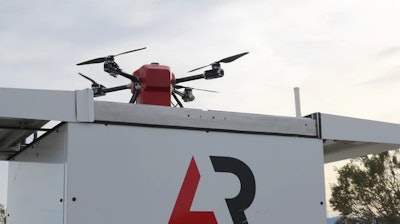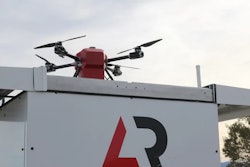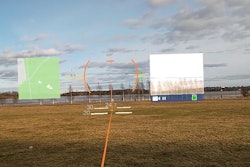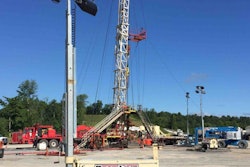
American Robotics has announced that the Federal Aviation Administration (FAA) is allowing the company to operate fully-automated drones without humans on site, or what is known as beyond visual line of sight (BVLOS).
The news is important on a few fronts:
- First, American Robotics is the first company allowed by the FAA to operate BVLOS drones.
- Second, it's an important milestone in BVLOS technology, which is the next frontier in the drone industry.
- Third, it brings the FAA closer to creating an Unmanned Aircraft System Traffic Management system.
- Fourth, it's one step closer to increased use of drones on construction job sites.
American Robotics made the announcement in recent days.
American Robotics Scout
The Scout is a fully-automated drone that runs missions autonomously, collecting, processing and analyzing data. The drone lives inside a weatherproof charging and data processing station out in the field.
The company’s Scout System™ features advanced acoustic Detect-and-Avoid (DAA) technology that enables its drones to maintain a safe distance from other aircraft at all times. By developing a layered, redundant system of safety that includes proprietary technical and operational risk mitigations, American Robotics has proven that its drone-based aerial intelligence platform operates safely in the National Airspace System (NAS), even when it conducts flights Beyond-Visual-Line-of-Sight (BVLOS) of the operator.
This approval represents a pivotal inflection point in the commercial drone industry. Prior waivers and certifications awarded by the FAA required visual observers (VOs) stationed along the flight path to keep eyes on the airspace at all times, or required other burdensome restrictions such as infrastructure masking. As a result, the value and scalability of commercial drone use in the U.S. has, until now, been drastically inhibited or in many cases eliminated.
With this approval, American Robotics’ Scout System is now the first drone technology allowed to continuously operate without this costly human requirement.
“With these approvals, American Robotics is ushering in a new era of widespread automated drone operations,” said Reese Mozer, CEO and co-founder of American Robotics. “Decades worth of promise and projection are finally coming to fruition. We are proud to be the first company to meet the FAA’s comprehensive safety requirements, which had previously restricted the viability of drone use in the commercial sector. We are very grateful for the FAA’s willingness to work closely with American Robotics over the past four years on this precedent-setting authorization. With this set of approvals, American Robotics can begin safely operating our automated Scout platform for the benefit of the energy, infrastructure, agriculture, and security market verticals, helping unlock the projected $100 billion commercial drone market.”
Drones for Commercial Data Collection
Over a four-year testing program, American Robotics has demonstrated the impact its Scout Systems can have on industrial and agricultural industries by engaging with multiple organizations across eight states in the U.S. During 2020, Scout Systems flew as many as 10 automated missions per day, capturing a variety of advanced data. The real-time analytics derived from this data allows farmers, agronomists, industrial operators, security personnel and maintenance crews to accurately track the health and status of their operations, at a resolution and frequency not previously possible.
“Our interest in American Robotics' technology started with the desire to have a drone imagery solution that was reliable, scalable, and executed with minimal human resources,” says Lance Ruppert, director of agronomy marketing and technology at Growmark, Inc., a U.S. grower cooperative. “This technology, along with the FAA approvals to operate it without humans on the ground, is key to making drones a widespread reality in our industry. This is a game changer."
The Scout System captures and processes data at resolutions, frequencies, and speeds never before feasible. Unlike other drone technology, Scout provides an unmatched level of autonomy, safety and analytics with its industrial-grade design and advanced, AI-powered software.
“The commercial drone industry is growing quickly and providing significant benefits to the American public, but enabling expanded operations beyond visual line of sight is critical for the industry to truly take off," says Lisa Ellman, partner and chair of the Global UAS Practice at Hogan Lovells, and executive director of the Commercial Drone Alliance. "Automated BVLOS operations are particularly important to opening the commercial sectors to the drone economy, including the agriculture and industrial verticals. Key to these operations is the use and FAA acceptance of new and innovative safety technologies, such as detect and avoid (DAA) sensors and software-enabled automation. American Robotics’ groundbreaking and exciting FAA approval is an important and significant step forward for the commercial drone community as a whole. The commercial drone industry looks forward to building on American Robotics’ success and continuing to work with the FAA toward safe integration of UAS into our National Airspace System.”
Unmanned Aircraft System Traffic Management system
According to the FAA, several federal agencies are working together to explore what's needed for a drone airspace of the future. Operation, data exchange requirements and a supporting framework are some of the concepts being explored to make this happen.
Unmanned Aircraft System Traffic Management (UTM) is a "traffic management" ecosystem for uncontrolled operations that is separate from, but complementary to, the FAA's Air Traffic Management (ATM) system. UTM development will ultimately identify services, roles and responsibilities, information architecture, data exchange protocols, software functions, infrastructure, and performance requirements for enabling the management of low-altitude uncontrolled drone operations.
UTM is how airspace will be managed to enable multiple drone operations conducted beyond visual line-of-sight (BVLOS), where air traffic services are not provided, according to the FAA.
With UTM, there will be a cooperative interaction between drone operators and the FAA to determine and communicate real-time airspace status. The FAA will provide real-time constraints to the UAS operators, who are responsible for managing their operations safely within these constraints without receiving positive air traffic control services from the FAA. The primary means of communication and coordination between the FAA, drone operators, and other stakeholders is through a distributed network of highly automated systems via application programming interfaces (API), and not between pilots and air traffic controllers via voice.

















